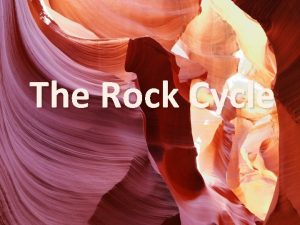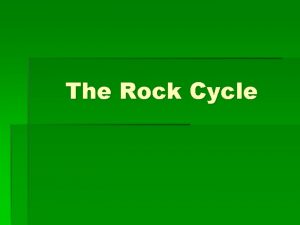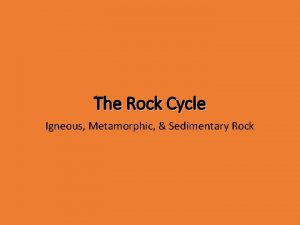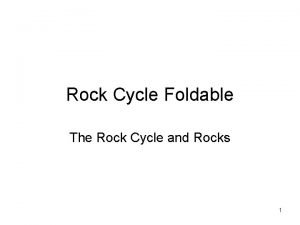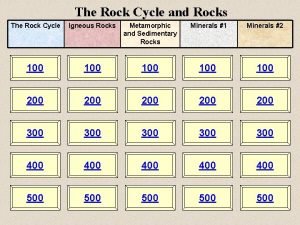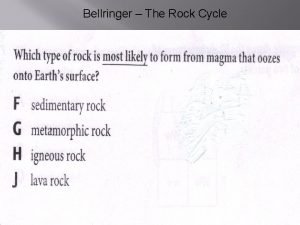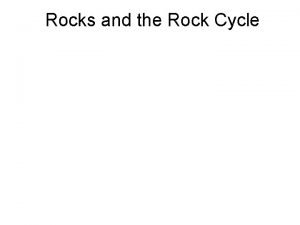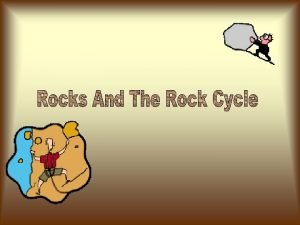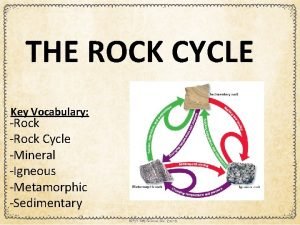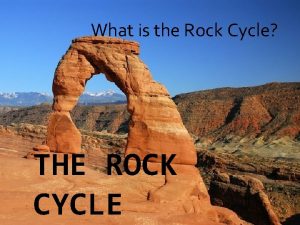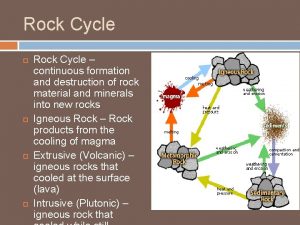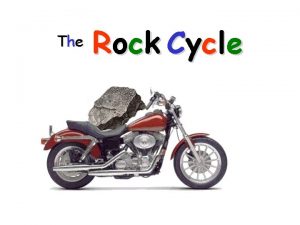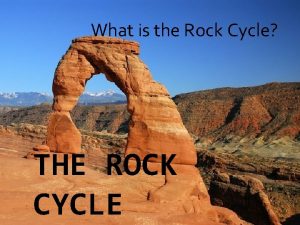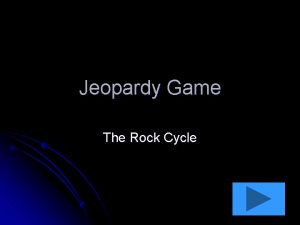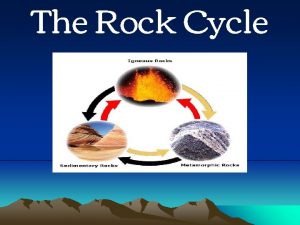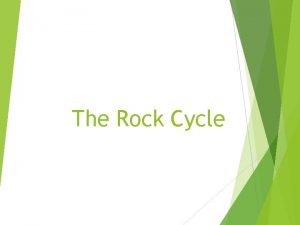The Rock Cycle The rock cycle is an



























- Slides: 27

The Rock Cycle

• The rock cycle is an ongoing process, beginning as rocks are pushed up by tectonic forces, and eroded by wind and rain. The eroded rocks travel by wind or moving water until they are deposited, settling into layers. • Additional eroded rocks may bury these layers until heat and pressure change the underlying layers to metamorphic rock. • More eroded rocks may squeeze and press the layers into sedimentary rocks. • Buried rocks may also melt and recrystalize into igneous rocks. • Metamorphic, sedimentary, and igneous rocks may then be pushed up by tectonic forces, starting the rock cycle again.

Three Types of Rocks • Igneous Rock • Metamorphic Rock • Sedimentary Rock

Igneous Rocks • Igneous rock is rock formed by the hardening and crystallization of molten material that originates deep within the earth. • The rocks of the Canadian Shield are made of igneous rock.

• The two best-known igneous rock types are basalt and granite • Basalt makes up most of the world’s oceanic crust.

• Igneous Basalt is dark, fine-grained rock from lava flows and magma intrusions. Its dark minerals are rich in magnesium and iron

• Igneous Columnar basalt in Eugene, Oregon

• Igneous Sometimes the iron-rich minerals in Basalt cause it to weather into reddish stains. California

Igneous Granite is light, coarse-grained rock formed at great depth under the earth’s surface and exposed after deep erosion. It is rich in quartz.

Igneous Granite

Igneous Granite Canadian Shield Granite.

Igneous Granite Glacial shaped Canadian Shield granite

Sedimentary Rocks • Sedimentary forms near the Earth's surface, wherever sediments can pile up and be gradually buried. • Whereas igneous rocks are born hot, sedimentary rocks are born cool. • Sedimentary rocks usually form under water. • They usually consist of layers.

Sedimentary

Sedimentary • Sedimentary rock eroded by wind and water. • Gabriola Island, British Columbia, Canada.

Sedimentary

Sedimentary Limestone Coal

Sedimentary Sandstone Shale

Sedimentary Fossilized Rocks

Metamorphic Rocks • Metamorphic rocks are the most complex rock class, forming by the compression and chemical alteration of other rocks, both sedimentary and igneous. • The four main agents that metamorphose rocks are heat, pressure, fluids and strain.

Metamorphic Slate (formerly sedimentary shale)

Metamorphic Schist (formed from clay minerals)

Metamorphic Gneiss • Gneiss is like schist but less strongly layered. • It is usually tougher. • It may derive from a rock with less clay.

Metamorphic Gneiss

Metamorphic Quartzite (formerly sandstone) Marble (formerly limestone)


The End
 Sedimentary rocks turn into metamorphic
Sedimentary rocks turn into metamorphic Rock cycle sedimentary
Rock cycle sedimentary Igneous rock to metamorphic rock
Igneous rock to metamorphic rock Climbing rock climbing
Climbing rock climbing Chapter 3 standardized test practice answers
Chapter 3 standardized test practice answers Chapter 3 standardized test practice answers
Chapter 3 standardized test practice answers Rock cycle diagram class 7
Rock cycle diagram class 7 Hát kết hợp bộ gõ cơ thể
Hát kết hợp bộ gõ cơ thể Bổ thể
Bổ thể Tỉ lệ cơ thể trẻ em
Tỉ lệ cơ thể trẻ em Voi kéo gỗ như thế nào
Voi kéo gỗ như thế nào Tư thế worm breton là gì
Tư thế worm breton là gì Alleluia hat len nguoi oi
Alleluia hat len nguoi oi Môn thể thao bắt đầu bằng từ chạy
Môn thể thao bắt đầu bằng từ chạy Thế nào là hệ số cao nhất
Thế nào là hệ số cao nhất Các châu lục và đại dương trên thế giới
Các châu lục và đại dương trên thế giới Công thức tính thế năng
Công thức tính thế năng Trời xanh đây là của chúng ta thể thơ
Trời xanh đây là của chúng ta thể thơ Mật thư tọa độ 5x5
Mật thư tọa độ 5x5 101012 bằng
101012 bằng Phản ứng thế ankan
Phản ứng thế ankan Các châu lục và đại dương trên thế giới
Các châu lục và đại dương trên thế giới Thể thơ truyền thống
Thể thơ truyền thống Quá trình desamine hóa có thể tạo ra
Quá trình desamine hóa có thể tạo ra Một số thể thơ truyền thống
Một số thể thơ truyền thống Cái miệng nó xinh thế
Cái miệng nó xinh thế Vẽ hình chiếu vuông góc của vật thể sau
Vẽ hình chiếu vuông góc của vật thể sau



























